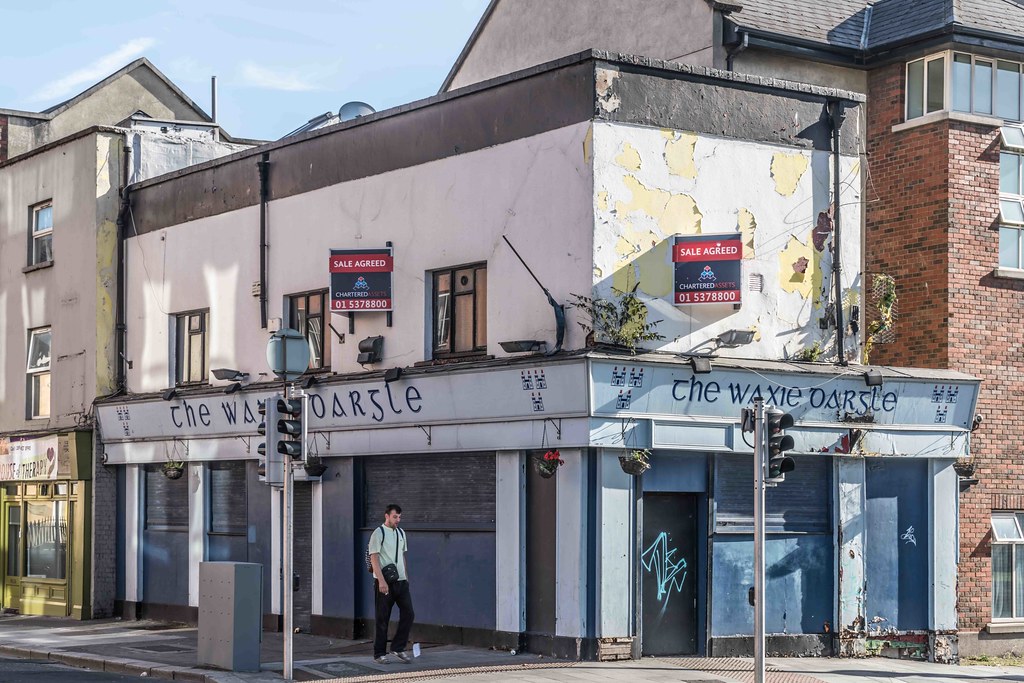
Custom Search
THE GREEN MENU OPTIONS ARE MOBILE FRIENDLY AND ARE FASTER SO THEY ARE RECOMMENDED. THE RED MENU OPTIONS ARE SOMEWHAT SLOWER DEPENDING ON YOUR DEVICE OR BROWSER AND ARE MORE SUITABLE FOR DESKTOPS AND LAPTOPS. THE BLUE OPTIONS ARE PAGE LINKS AND WILL BE PHASED OUT GOING FORWARD
THE WAXIE DARGLE PUB
"The Waxies' Dargle" is a traditional Irish folk song about two Dublin "aul' wans" (ladies) discussing how to find money to go on an excursion. It is named after an annual outing to Ringsend, near Dublin city, by Dublin cobblers (waxies). It originated as a 19th-century children's song and is now a popular pub song in Ireland.
In the 19th century, during the Summer, the gentry of Dublin would travel out to Bray and Enniskerry with their entourages and have picnics on the banks of the River Dargle. The Dargle was a popular holiday resort, and the name in Dublin slang became synonymous with "holiday resort".
The shoe-makers and repairers in Dublin were known as waxies, because they used wax to waterproof and preserve the thread they used in stitching the shoes.Easter and Whitsun were their principal holidays, Monday being the excursion for men and Tuesday for women. The original Waxies' Dargle was said to be part of Donnybrook Fair, but due to riotous behaviour this fair closed in 1855. In any case, the waxies' excursions did not go all the way to Bray, but only went as far as Irishtown which is located between Ringsend and Sandymount. In imitation of the gentry, they called their outing the Waxies' Dargle. They drove out from the city to Ringsend on flat drays, ten or a dozen to each vehicle. It cost two pence per car-load and the usual cry of the driver was "Tuppence, an' up with yeh!". Those who wanted a more comfortable ride could take a jaunting car from D'Olier Street for threepence.
Their destination was a favourite resort for Dubliners, a grass-covered triangle near the sea-front at Irishtown. On Summer evenings fiddlers, flautists and melodeon-players played dance music (sets, half-sets and reels) until midnight. There was a roaring trade in porter, cockles and mussels and "treacle Billy". On Bank holidays there were boxing contests.
There is an engraved stone, marking the location of the Waxies' Dargle "picnic" site near Gleesons Pub in Irishtown.
Robert Gogan describes how the "Waxies' Dargle" focuses on working-class Dublin. The places referenced are in areas frequented by the poor. Monto was an area around Montgomery Street, a notorious red-light district near the centre of Dublin. Capel Street is on the north side of the city and was renowned for its pawnbroking shops, a few of which remain to this day.
The Waxies' Dargle is also mentioned in another Dublin folk song, "Monto (Take Her Up to Monto)", written by George Desmond Hodnett.
The Waxies' Dargle is referenced in the Aeolus episode of the novel Ulysses by James Joyce. The character Myles Crawford refers to the two old ladies on top of Nelson's pillar as being "Out for the waxies' Dargle".
In the 19th century, during the Summer, the gentry of Dublin would travel out to Bray and Enniskerry with their entourages and have picnics on the banks of the River Dargle. The Dargle was a popular holiday resort, and the name in Dublin slang became synonymous with "holiday resort".
The shoe-makers and repairers in Dublin were known as waxies, because they used wax to waterproof and preserve the thread they used in stitching the shoes.Easter and Whitsun were their principal holidays, Monday being the excursion for men and Tuesday for women. The original Waxies' Dargle was said to be part of Donnybrook Fair, but due to riotous behaviour this fair closed in 1855. In any case, the waxies' excursions did not go all the way to Bray, but only went as far as Irishtown which is located between Ringsend and Sandymount. In imitation of the gentry, they called their outing the Waxies' Dargle. They drove out from the city to Ringsend on flat drays, ten or a dozen to each vehicle. It cost two pence per car-load and the usual cry of the driver was "Tuppence, an' up with yeh!". Those who wanted a more comfortable ride could take a jaunting car from D'Olier Street for threepence.
Their destination was a favourite resort for Dubliners, a grass-covered triangle near the sea-front at Irishtown. On Summer evenings fiddlers, flautists and melodeon-players played dance music (sets, half-sets and reels) until midnight. There was a roaring trade in porter, cockles and mussels and "treacle Billy". On Bank holidays there were boxing contests.
There is an engraved stone, marking the location of the Waxies' Dargle "picnic" site near Gleesons Pub in Irishtown.
Robert Gogan describes how the "Waxies' Dargle" focuses on working-class Dublin. The places referenced are in areas frequented by the poor. Monto was an area around Montgomery Street, a notorious red-light district near the centre of Dublin. Capel Street is on the north side of the city and was renowned for its pawnbroking shops, a few of which remain to this day.
The Waxies' Dargle is also mentioned in another Dublin folk song, "Monto (Take Her Up to Monto)", written by George Desmond Hodnett.
The Waxies' Dargle is referenced in the Aeolus episode of the novel Ulysses by James Joyce. The character Myles Crawford refers to the two old ladies on top of Nelson's pillar as being "Out for the waxies' Dargle".
LOADING
